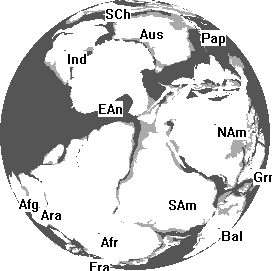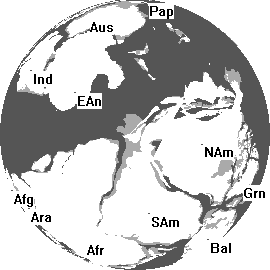Cryogenian Period 850 to 635 mya
Summary
The Cryogenian Period derives its name from the Greek word cryos meaning cold and genesis meaning birth.
The greatest ice age in history probably occurred during this period. This so-called ‘snowball earth' might have involved the whole Earth, although this is not yet established.
Earth 700 mya
Continents 700 mya
We have little idea where the continents had been for the first 4 billion years of Earth's history, but from about 700 mya we can begin to draw maps of where we think they were, based on the magnetic fields frozen into them as volcanic larva cooled into rock. Here is the first of our reconstructions.

Earth 700 mya. Click here for key. Next image. Image courtesy of TimeTrek
For the previous 100 million years, the supercontinent of Rodinia had been breaking up, splitting open across the middle to form an ocean called Tethys.
Notice that Africa (Afr) and South America (SAm) were joined together but upside-down relative to their orientations today.
This breakup had a significant effect on the climate and on life.
So to understand the changing climate, we need to know how and why continents move.
Continents 650 mya

Earth 650 mya.. Click here for key. Previous image. Next image. Image courtesy of TimeTrek
Rodinia split into Gondwana in the south and Laurasia in the north. By 650 mya the northern super-continent had drifted away from the southern, as the Tethys ocean was created between them.
